Study of Materials Behavior in a Monumental Vault Strengthened by a Carbon Net in a Mineral Matrix Subjected to Seismic Influence
Abstract
1. Introduction
2. Materials and Methods
2.1. Geometry of the Vault
- Vault coatings are 16 to 28 cm thick,
- The span of the vaults of the main nave is about 10.0 m, the side aisles −5 m,
- The width of the vault ribs is 20 and 29 cm.
2.2. Masonry and FRCM Material Testing
- (1)
- Compression—tensile in the x direction (Figure 5b),
- (2)
- Compression—tension in the y direction,
- (3)
- Shear in xy plane.
2.3. FE Model of the Masonry Vault
2.4. Data of the Seismic Sequence
2.5. Methods of Dynamic Investigation
3. Results
4. Conclusions
Author Contributions
Funding
Institutional Review Board Statement
Informed Consent Statement
Data Availability Statement
Conflicts of Interest
References
- Bertolesi, E.; Adam, J.M.; Rinaudo, R.; Calderón, P.A. Research and practice on masonry cross vaults—A review. Eng. Struct. 2019, 180, 67–88. [Google Scholar] [CrossRef]
- Chang-Hai, Z.; Zhi, Z.; Shuang, L.; Li-Li, X. Seismic analyses of a RCC building under mainshock–aftershock seismic sequences. Soil Dyn. Earthq. Eng. 2015, 74, 46–55. [Google Scholar]
- Cińcio, A. Numerical Analysis of Dynamic Resistance on Semi-Seismic Tremors of Low Buildings with Application of Spatial Object Models. Ph.D. Thesis, Silesian University of Technology, Gliwice, Poland, 2004. [Google Scholar]
- Thamboo, J.; Bandara, J.; Perera, S.; Navaratnam, S.; Poologanathan, K.; Corradi, M. Experimental and Analytical Study of Masonry Subjected to Uniaxial Cyclic Compression. Materials 2020, 13, 4505. [Google Scholar] [CrossRef] [PubMed]
- D’Altri, A.M.; Castellazzi, G.; Miranda, S.; Tralli, A. Seismic-induced damage in historical masonry vaults: A case-study in the 2012 Emilia earthquake-stricken area. J. Build. Eng. 2017, 13, 224–243. [Google Scholar] [CrossRef]
- Asteris, P.G.; Douvika, M.G.; Apostolopoulou, M.; Moropoulou, A. Seismic and Restoration Assessment of Monumental Masonry Structures. Materials 2017, 10, 895. [Google Scholar] [CrossRef]
- Valvona, F.; Toti, J.; Gattulli, V.; Potenza, F. Effective seismic strengthening and monitoring of a masonry vault by using Glass Fiber Reinforced Cementitious Matrix with embedded Fiber Bragg Grating sensors. Compos. Part B Eng. 2017, 113, 355–370. [Google Scholar] [CrossRef]
- Ferretti, E.; Pascale, G. Combined Strengthening Techniques to Improve the Out-of-Plane Performance of Masonry Walls. Materials 2019, 12, 1171. [Google Scholar] [CrossRef]
- Corradi, M.; Castori, G.; Sisti, R.; Borri, A.; Pesce, G.L. Repair of Block Masonry Panels with CFRP Sheets. Materials 2019, 12, 2363. [Google Scholar] [CrossRef]
- Krajewski, P.; Hojdys, Ł. Experimental studies on buried barrel vaults. Int. J. Archit. Herit. Conserv. Anal. Restor. 2015, 9, 834–843. [Google Scholar] [CrossRef]
- Pineda, P. Collapse and upgrading mechanisms associated to the structural materials of a deteriorated masonry tower. Nonlinear assessment under different damage and loading levels. Eng. Fail. Anal. 2016, 63, 72–93. [Google Scholar] [CrossRef]
- Valente, M.; Milani, G. Earthquake-induced damage assessment and partial failure mechanisms of an Italian Medieval castle. Eng. Fail. Anal. 2019, 99, 292–309. [Google Scholar] [CrossRef]
- Chiozzia, A.; Grillanda, N.; Milani, G.; Tralli, A. UB-ALMANAC: An adaptive limit analysis NURBS-based program for the automatic assessment of partial failure mechanisms in masonry churches. Eng. Fail. Anal. 2018, 85, 201–220. [Google Scholar] [CrossRef]
- Lin, C.H. Foreshock characteristics in Taiwan: Potential earthquake warning. J. Asian Earth Sci. 2009, 34, 655–662. [Google Scholar] [CrossRef]
- Ruiz-García, J.; Negrete-Manriquez, J.C. Evaluation of drift demands in existing steel frames under as-recorded far-field and near-fault mainshock–aftershock seismic sequences. Eng. Struct. 2011, 33, 621–634. [Google Scholar] [CrossRef]
- Shin, J.; Jeon, J.S.; Kim, J.H. Mainshock-aftershock response analyses of FRP-jacketed columns in existing RC building frames. Eng. Struct. 2018, 165, 315–330. [Google Scholar] [CrossRef]
- Zhang, S.; Wang, G.; Sa, W. Damage evaluation of concrete gravity dams under mainshock–aftershock seismic sequences. Soil Dyn. Earthq. Eng. 2013, 50, 16–27. [Google Scholar] [CrossRef]
- Luzi, L.; Pacor, R.; Puglia, R. Italian Accelerometric Archive v3.0. Istituto Nazionale di Geofisica e Vulcanologia. Dipartimento della Protezione Civile Nazionale. Available online: http://itaca.mi.ingv.it/ItacaNet_30/#/home (accessed on 11 July 2020).
- Lee, J.; Fenves, G.L. Plastic-damage model for cyclic loading of concrete structures. J. Eng. Mech. 1998, 124, 892–900. [Google Scholar] [CrossRef]
- Bednarz, Ł.J.; Jasieńko, J.; Rutkowski, M.; Nowak, T.P. Strengthening and long-term monitoring of the structure of an historical church presbytery. Eng. Struct. 2014, 81, 62–75. [Google Scholar] [CrossRef]
- Drygala, I.J.; Dulinska, J.M.; Bednarz, Ł.; Jasienko, J. Seismic Performance of a Historical Apartment Building Using a Barcelona Model (BM) Adapted for Masonry Walls. Key Eng. Mater. 2017, 747, 646–652. [Google Scholar] [CrossRef]
- Wawrzynek, A.; Cińcio, A.; Fedorowicz, J. Numerical verification of the Barcelona Model adapted for brick walls. In Proceedings of the 7th International Masonry Conference (7IMC), London, UK, 30 October–1 November 2006; Volume 30, pp. 31–84. [Google Scholar]
- Jasieńko, J.; Łodygowski, T.; Rapp, P. Naprawa, Konserwacja i Wzmacnianie Wybranych, Zabytkowych Konstrukcji Ceglanych; Dolnośląskie Wydawnictwo Edukacyjne: Wroclaw, Poland, 2006. [Google Scholar]
- Bednarz, Ł. Praca Statyczna Zabytkowych, Zakrzywionych Konstrukcji Ceglanych Poddanych Zabiegom Naprawy i Wzmacniania. Ph.D. Thesis, Wrocław University of Science and Technology, Wrocław, Poland, 2008. [Google Scholar]
- Lopez, J.; Oller, S.; Onate, E.; Lubliner, J. A homogeneous constitutive model for masonry. Int. J. Numer. Methods Eng. 1999, 46, 1651–1671. [Google Scholar] [CrossRef]
- Kuczma, M.; Wybranowska, K. Numerical homogenization of elastic brick masonry. Civ. Environ. Eng. Rep. 2005, 1, 135–152. [Google Scholar]
- Simulia ABAQUS. Users’ Manual Documentation, Version 6.13; Simulia: Johnston, RI, USA, 2013. [Google Scholar]
- Mrożek, M. Numeryczna Symulacja Wzmacniania Matami CFRP Konstrukcji Murowych z Cegły. Ph.D. Thesis, Silesian University of Technology, Gliwice, Poland, 2012. [Google Scholar]
- Passowicz, A.; Norberciak, D.; Sielicki, P. Analiza Numeryczna Konstrukcji Kościoła Najświętszej Marii Panny na Ostrowie Tumskim w Poznaniu. Master’s Thesis, Poznań University of Technology, Poznań, Poland, 2005. [Google Scholar]



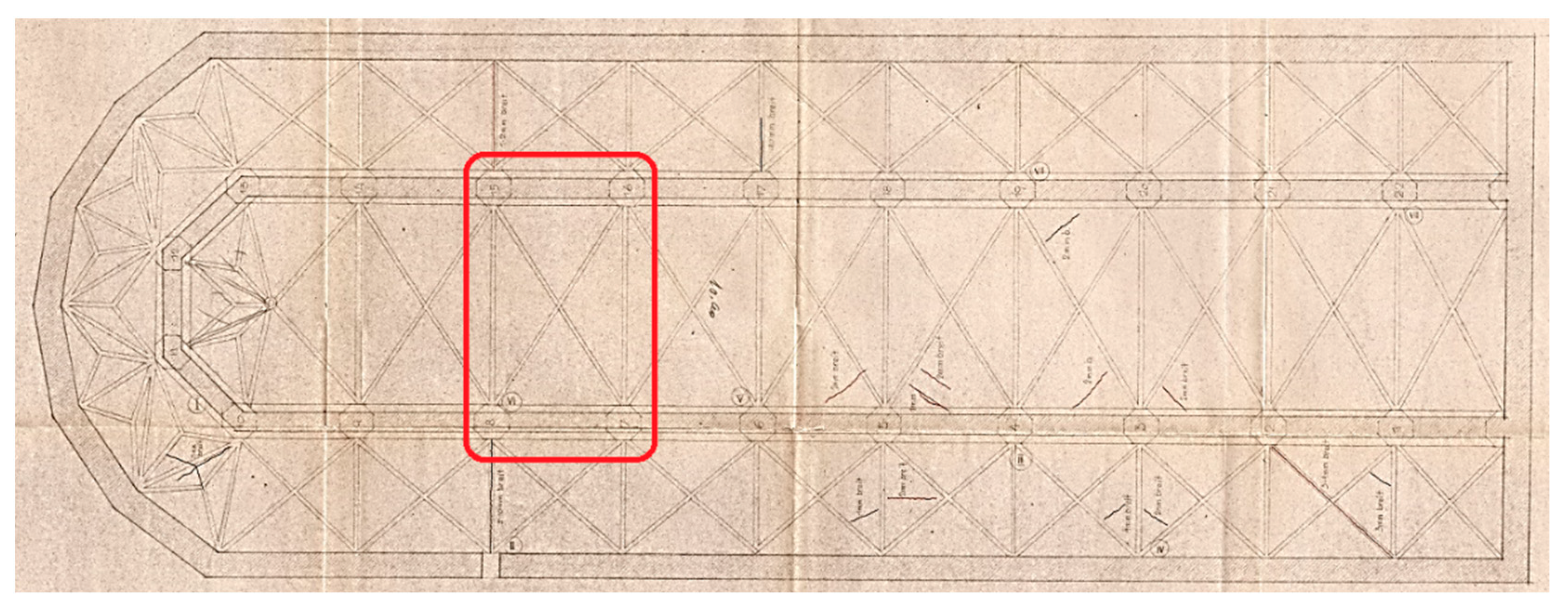
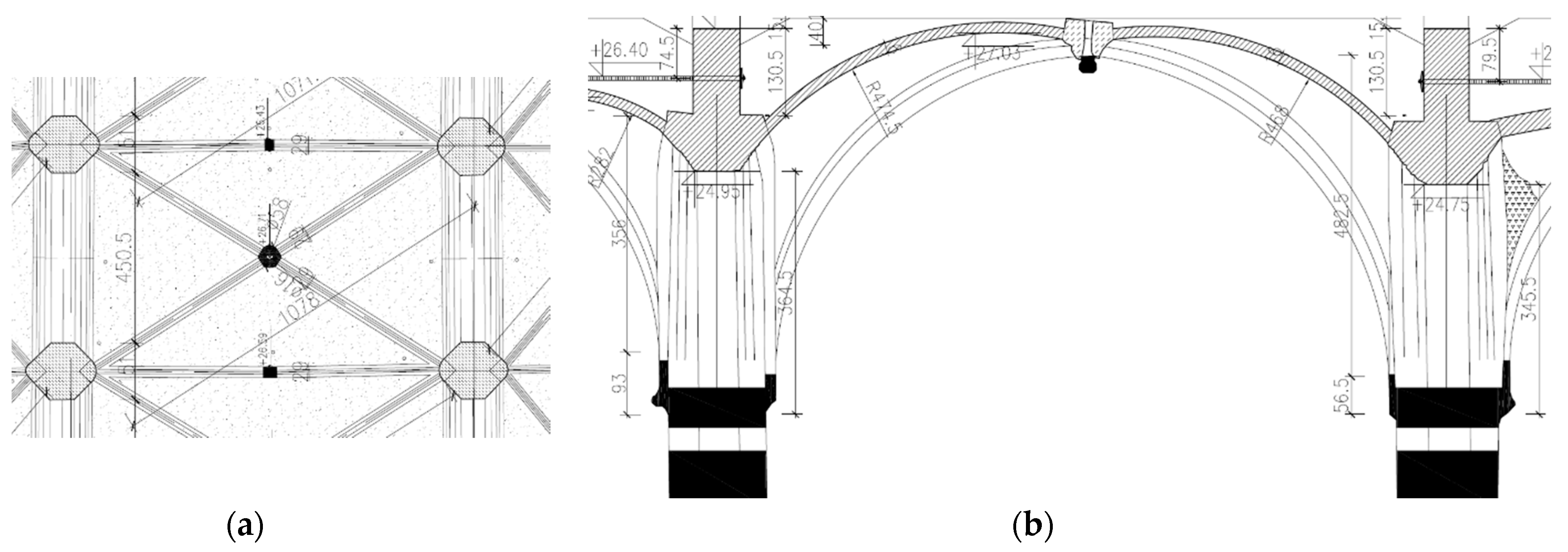
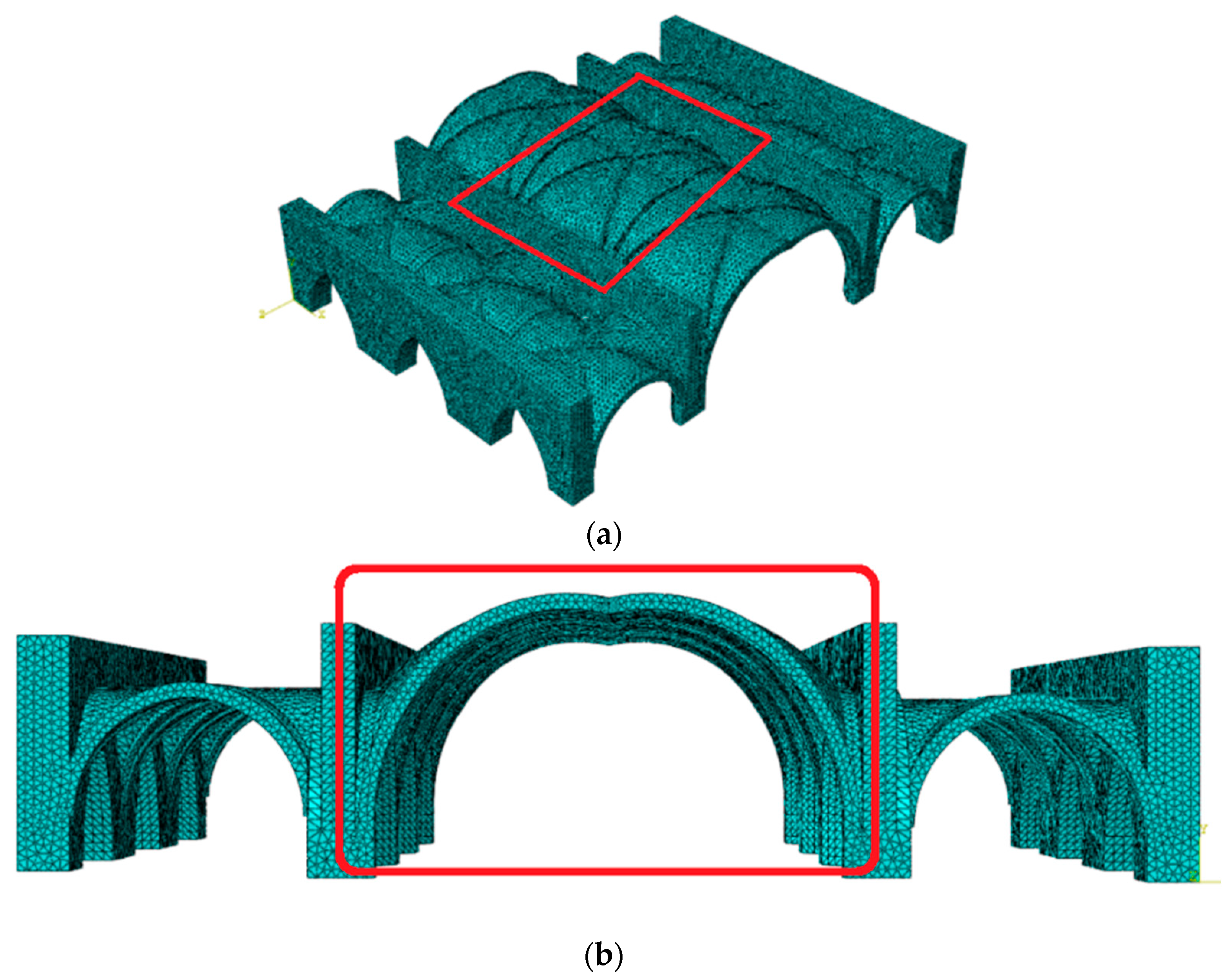

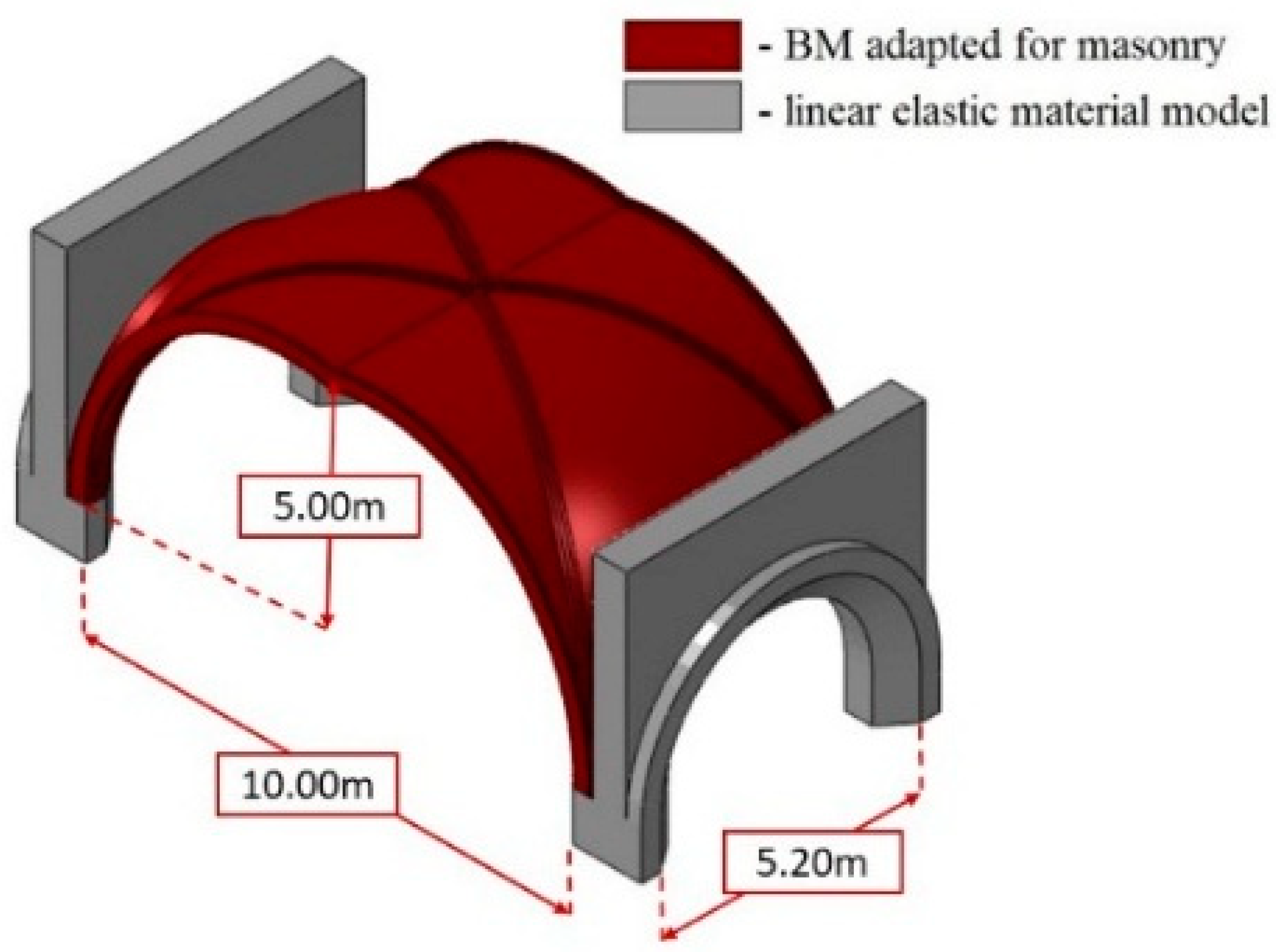
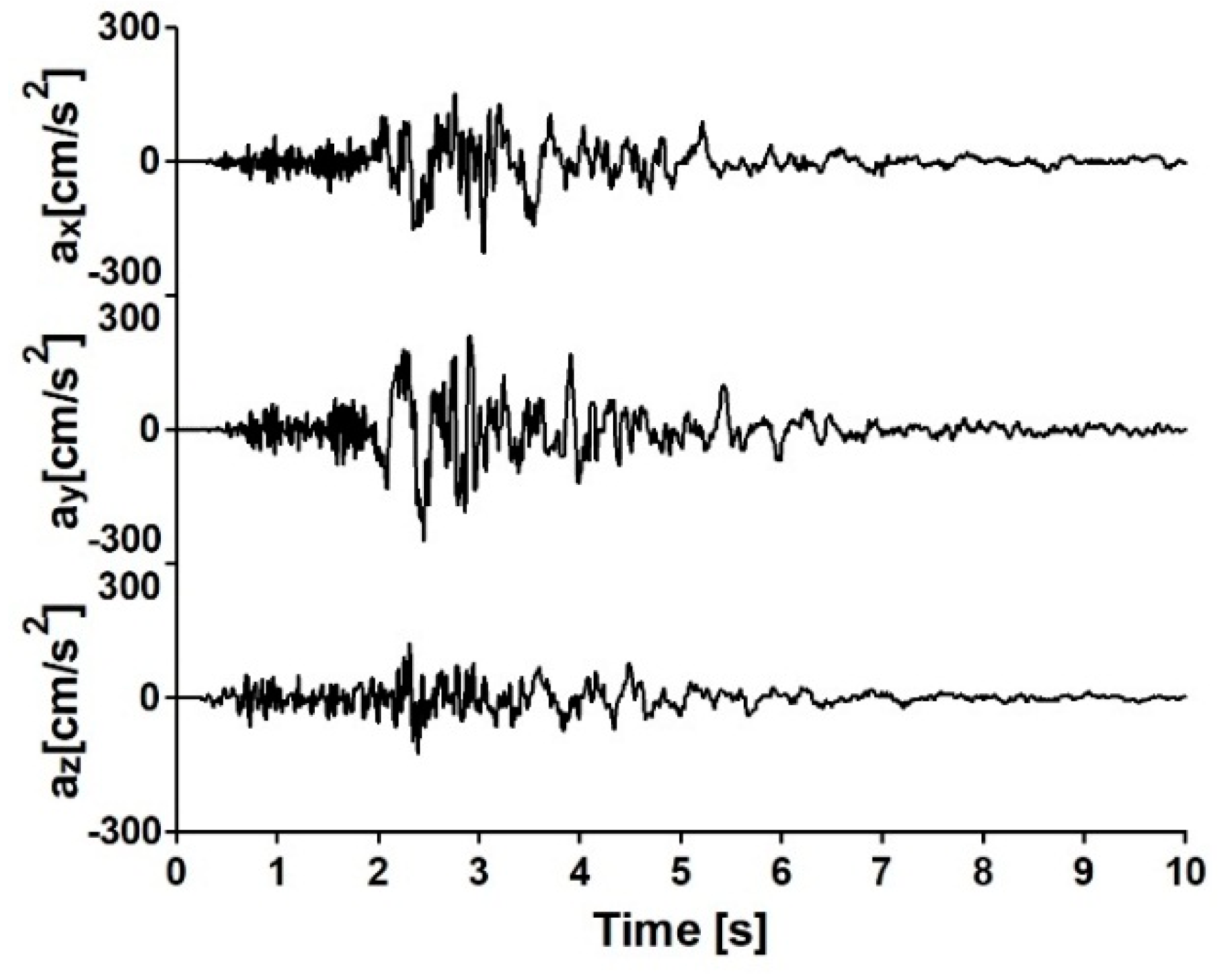

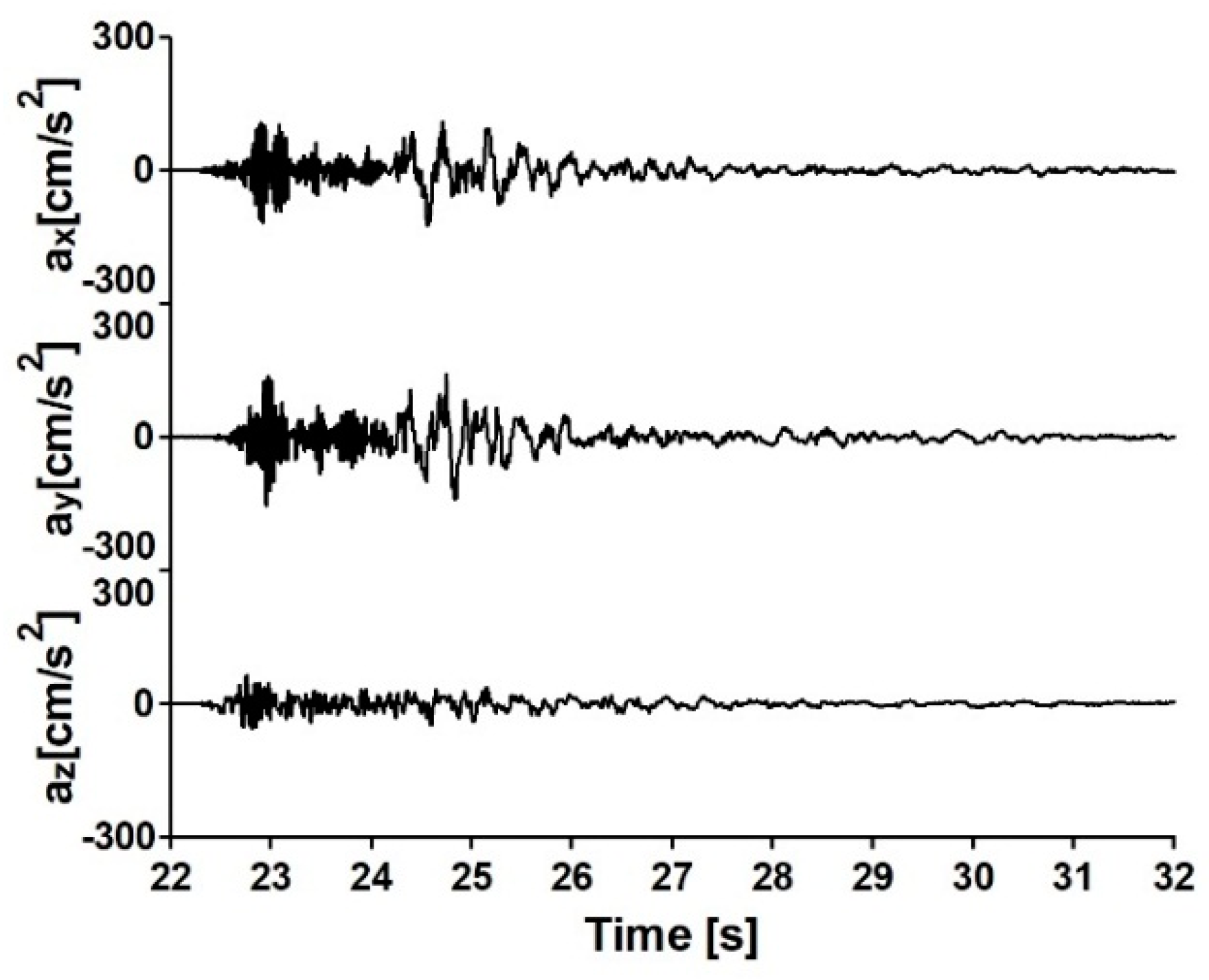
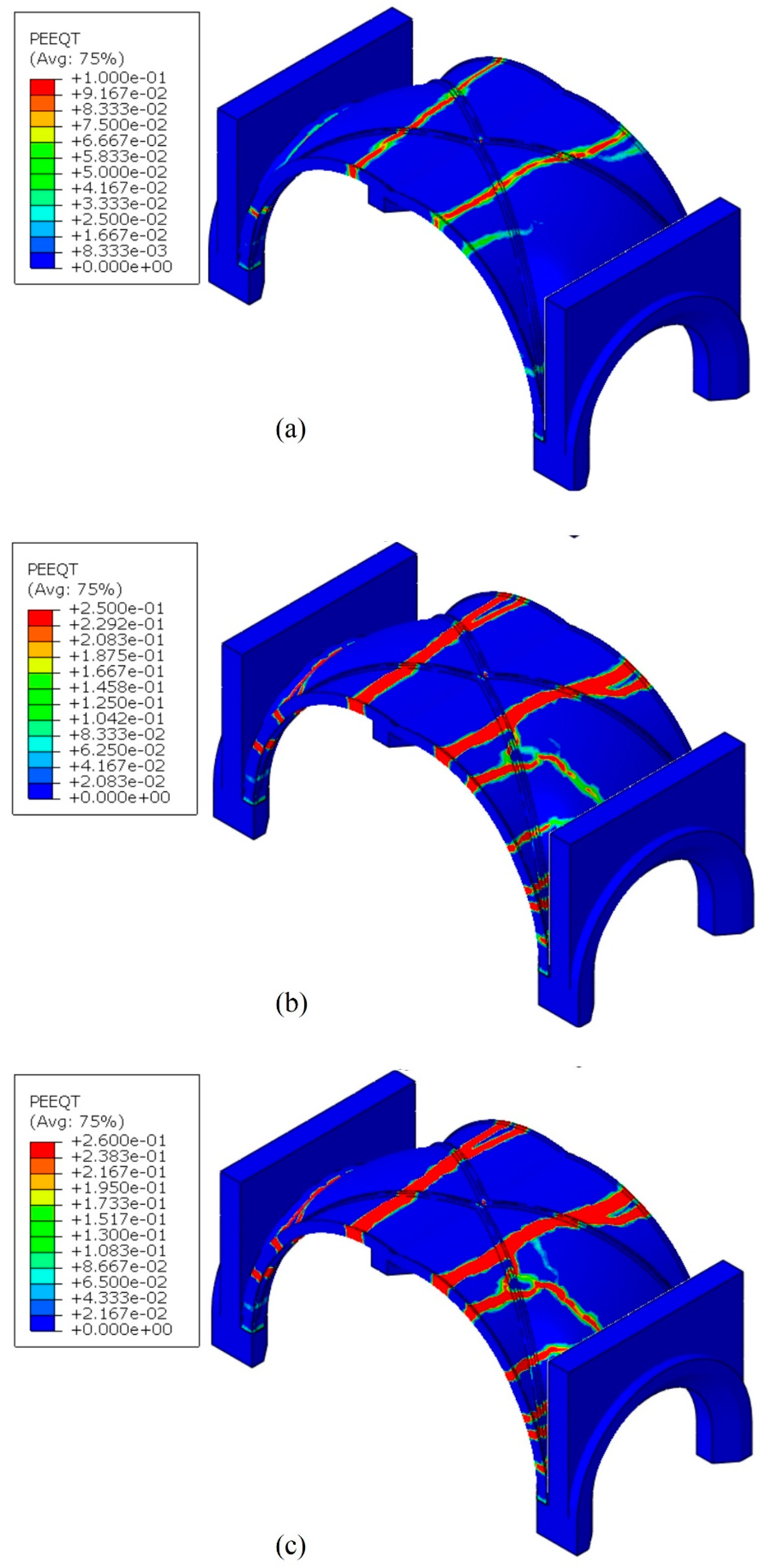

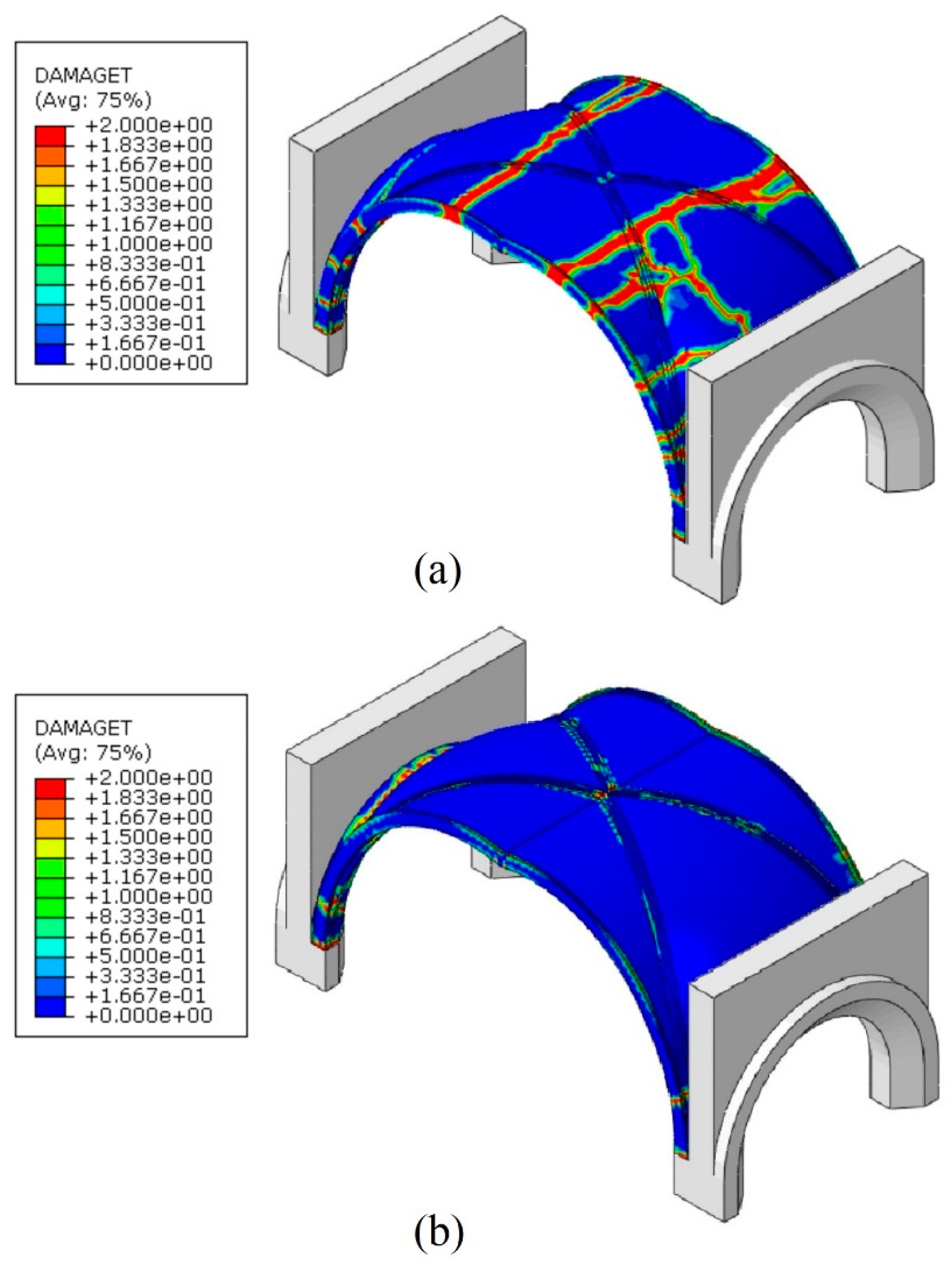
| Material | Modulus of Elasticity E | Poisson’s Ratio ν | Shear Modulus G |
|---|---|---|---|
| [MPa] | [−] | [MPa] | |
| masonry | 9480 | 0.6 | 4300 |
| carbon net | 240,000 | 0.4 | 5000 |
| Tension Stiffening | Tension Damage | ||
| Stress [MPa] | Cracking strain [−] | dt [%] | Cracking strain [−] |
| 0.20 | 0.00 | 0.00 | 0.00 |
| 0.05 | 0.000792 | 0.75 | 0.000792 |
| Compression Hardening | Compression Damage | ||
| Stress [MPa] | Crushing strain [−] | dc [−] | Crushing strain [−] |
| 2.00 | 0.00 | 0.00 | 0 |
| 0.5 | 0.007920 | 0.75 | 0.00792 |
| Date | Seismic Event | The Peak Ground Accelerations (PGA) [cm/s2] | ||
|---|---|---|---|---|
| E–W | N–S | Vertical | ||
| 2017-01-18 10:14:12 | 1st shock | 203.92 | 247.21 | 125.18 |
| 2017-01-18 10:25:26 | 2nd shock | 208.57 | 265.97 | 157.55 |
| 2017-01-18 13:33:37 | 3rd shock | 123.40 | 153.85 | 64.28 |
Publisher’s Note: MDPI stays neutral with regard to jurisdictional claims in published maps and institutional affiliations. |
© 2021 by the authors. Licensee MDPI, Basel, Switzerland. This article is an open access article distributed under the terms and conditions of the Creative Commons Attribution (CC BY) license (http://creativecommons.org/licenses/by/4.0/).
Share and Cite
Bednarz, Ł.; Drygała, I.; Dulińska, J.; Jasieńko, J. Study of Materials Behavior in a Monumental Vault Strengthened by a Carbon Net in a Mineral Matrix Subjected to Seismic Influence. Appl. Sci. 2021, 11, 1015. https://doi.org/10.3390/app11031015
Bednarz Ł, Drygała I, Dulińska J, Jasieńko J. Study of Materials Behavior in a Monumental Vault Strengthened by a Carbon Net in a Mineral Matrix Subjected to Seismic Influence. Applied Sciences. 2021; 11(3):1015. https://doi.org/10.3390/app11031015
Chicago/Turabian StyleBednarz, Łukasz, Izabela Drygała, Joanna Dulińska, and Jerzy Jasieńko. 2021. "Study of Materials Behavior in a Monumental Vault Strengthened by a Carbon Net in a Mineral Matrix Subjected to Seismic Influence" Applied Sciences 11, no. 3: 1015. https://doi.org/10.3390/app11031015
APA StyleBednarz, Ł., Drygała, I., Dulińska, J., & Jasieńko, J. (2021). Study of Materials Behavior in a Monumental Vault Strengthened by a Carbon Net in a Mineral Matrix Subjected to Seismic Influence. Applied Sciences, 11(3), 1015. https://doi.org/10.3390/app11031015








